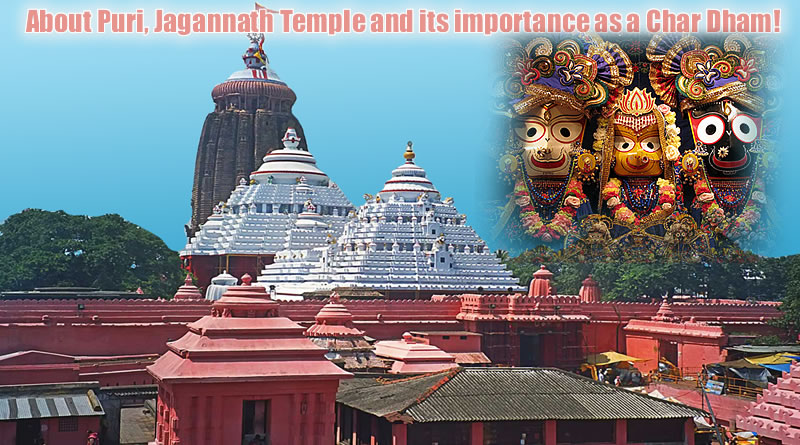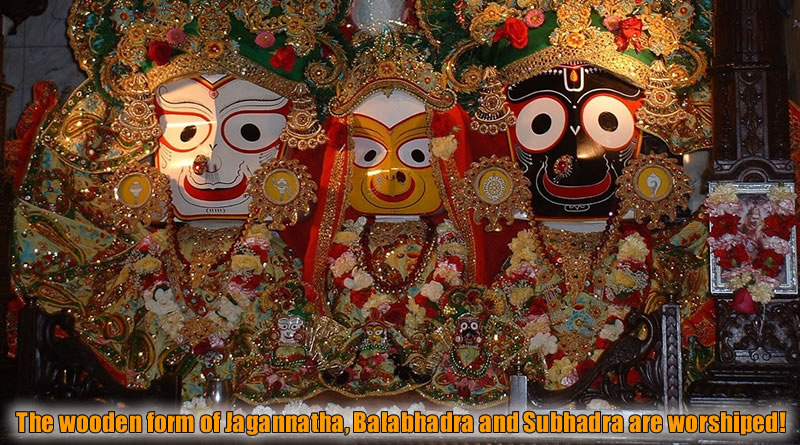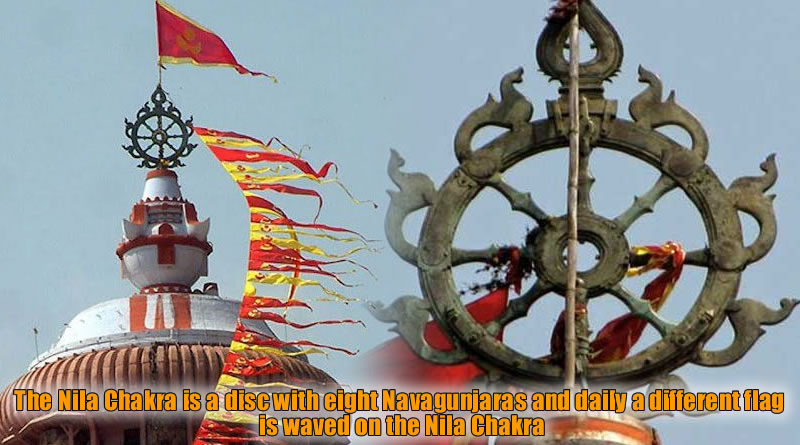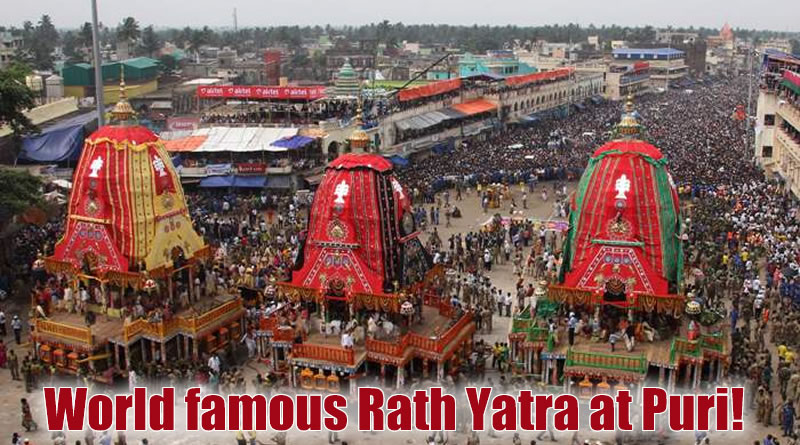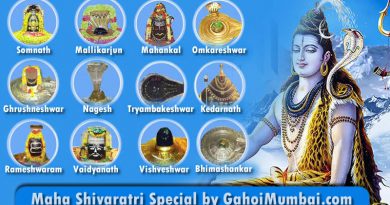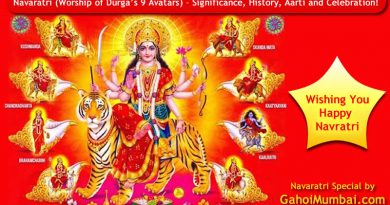About Puri, Jagannath Temple and its importance as a Char Dham!
Puri is one of the significant Dham in all four Char Dham. Puri, the holy land of Lord Jaganath, has many names. It is mentioned in Puranas as Srikshetra, Shankhakshetra, Neelāchala, Neelādri, Purusottama Dhāma, Purusottama Kshetra, Purusottama Puri and Jagannath Puri. The word “Puri” in Sanskrit means ‘town’ or ‘city’ and is related with polis in Greek. It is possible that Puri is a shortened name for Jagannath Puri or Purusottama Puri.
About Puri Town:
Puri is a holy city and the district headquarters of Puri district, Odisha, eastern India. It is located on the Bay of Bengal, 60 kilometres (37 mi) south of the state capital of Bhubaneswar. It is also known as Jagannath Puri after the 11th-century Jagannath Temple situated in the city. It is one of the original Char Dham pilgrimage sites for Indian Hindus, of which the other sites are Dwaraka, Badrinath and Rameswaram. As per to Hindu teachings, a pilgrimage of the temples of India is not considered complete without a journey to Puri.
New Jagannath Sadak connects Puri with western and southern Odisha.
Puri Beach is a famous beach resort. Sun Temple Konark is at distance of around 35 km from Puri.
Significance of Puri:
Puri, the holy land of Lord Jaganath, has many names. It is mentioned in Puranas as Srikshetra, Shankhakshetra, Neelāchala, Neelādri, Purusottama Dhāma, Purusottama Kshetra, Purusottama Puri and Jagannath Puri. The word “Puri” in Sanskrit means ‘town’ or ‘city’ and is related with polis in Greek. It is possible that Puri is a shortened name for Jagannath Puri or Purusottama Puri. In some records pertaining to the British rule, the word ‘Jagannath’ was used for Puri. It is the only shrine in India, where Radha, along with Lakshmi, Durga, Sati, Parvati, and Shakti abodes with Krishna, also known as Jagannath.
About Jagannath temple and its history and architecture:
The Jagannath Temple in Puri is a well-known, holy Hindu temple devoted to Jagannath and situated on the eastern coast of India, at Puri in the state of Odisha. The name Jagannath comes from the word Jagat-Nath which means ‘Lord of the Universe’ (Jagat = world, Nath = Master/protector).
In Jagannath, the ‘t’ word becomes an ‘n’ to mean lord (nath) of the world. and also, the word “Jagannatha” is evolved from “Jagati” (as an elevated platform or “Ratnabedi” on which the wooden form of Jagannatha, Balabhadra and Subhadra are worshiped on or the temple) and “Natha” (means “Lord”). Even in the western language, there exists a word ‘juggernaut’ that means once a person or artifact gets going, it cannot be stopped, thrashing all that comes in its way.
The temple is a significant pilgrimage destination for many Hindu traditions, particularly worshippers of Krishna and Vishnu, and part of the Char Dham pilgrimages that a Hindu is likely to make in one’s lifetime.
Even though most Hindu deities that are worshiped are made out of stone or metal, the image of Jagannath is wooden. Every twelve years these wooden figures are ritually replaced by using sacred trees that have to be carved as an exact replica. The reason behind this ceremonial tradition is the highly secret Navakalevara (‘New Body’ or ‘New Embodiment’) ceremony, an intricate set of rituals that accompany the renewal of the wooden statues.
The temple was built in the 12th century atop its ruins by the progenitor of the Eastern Ganga dynasty, King Anantavarman Chodaganga Deva. The temple is well-known for its annual Rath Yatra, or chariot festival, in which the three main temple deities are hauled on huge and elaborately decorated temple cars. Since medieval times, it is also associated with intense pious fervor.
Structure of temple:
The temple is sacred to the Vaishnava traditions and saint Ramananda who was closely associated with the temple. It is also of specific importance to the followers of the Gaudiya Vaishnavism whose founder, Chaitanya Mahaprabhu, was attracted to the deity, Jagannath, and lived in Puri for many years.
The central forms of Jagannath, Balabhadra and the goddess Subhadra constitute the trinity of deities sitting on the bejeweled platform or the Ratnavedi in the inner sanctum. The Sudarshan Chakra, deities of Madanmohan, Sridevi and Vishwadhatri are also placed on the Ratnavedi. The deities of Jagannath, Balabhadra, Subhadra and Sudarshan Chakra are made from sacred Neem logs known as Daru Bramha. Depending on the season the deities are adorned in different garbs and jewels. Worship of the deities pre-date the temple structure and may have originated in an ancient tribal shrine.
The huge temple complex covers an area of over 400,000 square feet (37,000 m2), and is surrounded by a high fortified wall. This 20 feet (6.1 m) high wall is known as Meghanada Pacheri. Another wall famous as kurma bedha surrounds the main temple. It contains at least 120 temples and shrines. With its sculptural richness and fluidity of the Oriya style of temple architecture, it is one of the most magnificent monuments of India. The temple has four distinct sectional structures, namely as Deula, Vimana or Garba griha (Sanctum sanctorum) where the triad deities are lodged on the ratnavedi (Throne of Pearls).
Nata mandir/Natamandapa, which is also famous as the Jagamohan (Audience Hall/Dancing Hall), and Bhoga Mandapa (Offerings Hall).
The main temple is a curvilinear temple and crowning the top is the ‘srichakra’ (an eight spoked wheel) of Vishnu. Also known as the “Nilachakra”, it is made out of Ashtadhatu and is considered sacrosanct. Among the present temples in Orissa, the temple of Shri Jagannath is the highest. The temple tower was built on a raised platform of stone and, rising to 214 feet (65 m) above the inner sanctum where the deities reside, dominates the surrounding landscape. The pyramidal roofs of the surrounding temples and adjoining halls, or mandapas, rise in steps toward the tower like a ridge of mountain peaks.
Nila Chakra:
The Nila Chakra (Blue Discus) is the discus mounted on the top shikhar of the Jagannath Temple. As per tradition, daily a different flag is waved on the Nila Chakra. The flag hoisted on the Nila Cakra is called the Patita Pavana (Purifier of the Fallen) and is equivalent to the image of the deities placed in the sanctum sanctorum.
The Nila Chakra is a disc with eight Navagunjaras carved on the outer circumference, with all facing towards the flagpost above. It is made of alloy of eight metals (Asta-dhatu) and is 3.5 Metres (11 feet and 8 inches) high with a circumference of about 11 metres (36 feet). During the year 2010, the Nila Chakra was repaired and restored by the Archaeological Survey of India.
The Nila Chakra is dissimilar from the Sudarshana chakra which has been placed with the deities in the inner sanctorum.
Nila Chakra is the most revered iconic symbol in the Jagannath cult. The Nila Chakra is the only physical object whose markings are used as sacrament and considered sacred in Jagannath worship. It symbolizes protection by Shri Jagannath.
The Singhadwara:
The Singahdwara, which in Sanskrit means The Lion Gate, is one of the four gates to the temple and forms the Main entrance. The Singhadwara is so named because two huge statues of crouching lions exist on either side of the entrance. The gate faces east opening on to the Bada Danda or the Grand Road. The Baisi Pahacha or the flight of twenty two steps leads into the temple complex. An idol of Jagannath known as Patitapavana, which in Sanskrit, means the “Saviour of the downtrodden and the fallen” is painted on the right side of the entrance. In ancient times when untouchables were not allowed inside the temple, they could pray to Patita Pavana. The statues of the two guards to the temple Jaya and Vijaya stand on either side of the doorway. Just before the commencement of the Rath Yatra the idols of Jagannath, Balabhadra and Subhadra are taken out of the temple through this gate. On their return from the Gundicha Temple they have to ritually placate Goddess Mahalakshmi, whose statue is carved atop the door, for neglecting to take her with them on the Yatra. Only then the Goddess allows them permission to enter the temple. A wonderful sixteen-sided monolithic pillar known as the Arun stambha stands in front of the main gate. This pillar has an idol of Arun, the charioteer of the Sun God Surya, on its top. One significant thing about Arun stambha is that prior it was located in the Konark Sun temple, later, the Maratha guru Brahmachari Gosain brought this pillar from Konark. The Puri Jagannath Temple was also saved by Maratha emperor Chhatrapati Shivaji Maharaj from being plundered at his times from the Mughals.
Other Entrances:
Apart from the Singhadwara, which is the main entrance to the temple, there are three other entrances facing north, south and west. They are named after the sculptures of animals guarding them. The other entries are the Hathidwara or the Elephant Gate, the Vyaghradwara or the Tiger Gate and the Ashwadwara or the Horse Gate.
Mini Temples:
There are many smaller temples and shrines within the Temple complex where active worship is frequently conducted.
The Vimala Temple (Bimala Temple) is considered one of the most important of the Shaktipeeths marks the spot where the goddess Sati’s feet fell. It is located near Rohini Kund in the temple complex. Until food offered to Jagannath is offered to Goddess Vimala it is not considered Mahaprasad.
The temple of Mahalakshmi has a significant role in rituals of the main temple. It is said that preparation of naivedya as offering for Jagannath is supervised by Mahalakshmi.
The Kanchi Ganesh Temple is dedicated to Uchhista Ganapati. Belief reveals the King of Kanchipuram (Kanchi) in ancient times gifted the idol, when Gajapati Purushottama Deva married Padmavati, the kanchi princess.
There are other shrines specifically Muktimandap, Surya, Saraswati, Bhuvaneshwari, Narasimha, Rama, Hanuman and Eshaneshwara.
The Mandapas:
There are numerous Mandapas or Pillared halls on raised platforms within the temple complex meant for sacred worshipers.
The most prominent is the Mukti Mandapa the congregation hall of the holy seat of selected learned Brahmins. Here important decisions regarding conduct of daily worship and festivals are taken.
The Dola Mandapa is noteworthy for a beautifully carved stone Torana or arch which is used for constructing a swing for the annual Dol Yatra festival. During the festival the idol of Dologobinda is placed on the swing.
The Snana Bedi is a rectangular stone podium where idols of Jagannath, Balabhadra and Subhadra are placed for ceremonial bathing during the annual Snana Yatra.
Puri history and its associated Myths:
As per to the recently discovered copper plates from the Ganga dynasty, the construction of the current Jagannath temple was initiated by the ruler of Kalinga, Anantavarman Chodaganga Dev. The Jaga mohan and the Vimana portions of the temple were built during his reign (1078 – 1148 CE). However, it was only in the year 1174 CE that the Oriya ruler Ananga Bhima Deva rebuilt the temple to give a shape in which it stands today.
Jagannath worship in the temple continued until 1558, when Odisha was attacked by the Afghan general Kalapahad. Afterward, when Ramachandra Deb established an independent kingdom at Khurda in Orissa, the temple was consecrated and the deities reinstalled.
Legendary account as found in the Skanda-Purana, Brahma Purana and other Puranas and later Oriya works state that Lord Jagannath was originally worshipped as Lord Neela Madhaba by a Savar king (tribal chief) named Viswavasu. Having heard about the god, King Indradyumna sent a Brahmin priest, Vidyapati to locate the deity, who was worshipped secretly in a dense forest by Viswavasu. Vidyapati tried his best but could not locate the place. But at last he managed to wed Viswavasu’s daughter Lalita. At constant request of Vidyapti, Viswavasu took his son-in-law blind folded to a cave where Lord Neela Madhaba was worshipped.
Vidyapati was very intellectual. He dropped mustard seeds on the ground on the way. The seeds germinated after a few days, which enabled him to find out the cave later on. On hearing from him, King Indradyumna proceeded instantly to Odra desha Orissa on a pilgrimage to see and worship the God. But the deity had disappeared. The king was saddened. The Deity was hidden in sand. The king was determined not to return without having a darshan of the deity and observed fast unto death at Mount Neela, Then a celestial voice cried ‘thou shalt see him.’ Later the king performed a horse sacrifice and built a magnificent temple for Vishnu. Sri Narasimha Murti brought by Narada was installed in the temple. During sleep, the king had a vision of Lord Jagannath. Also an astral voice directed him to receive the fragrant tree on the seashore and make idols out of it. Accordingly the king got the image of Lord Jagannath, Balabhadra, Subhadra and Chakra Sudarshan made out of the wood of the divine tree and installed them in the temple.
An another old story concerning the origins of the Lord Jagannath temple is that here the original image of Jagannath (a deity form of Vishnu) at the end of Treta yuga manifested near a banyan tree, near seashore in the form of an Indranila nilamani or the Blue Jewel. It was so amazing that it could grant instant moksha, so the god Dharma or Yama wanted to hide it in the earth, and was successful. In Dvapara Yuga King Indradyumna of Malwa wanted to find that mysterious image and to do so he performed harsh penances to obtain his goal. Vishnu then instructed him to go to the Puri seashore and find a floating log to make an image from its trunk.
The King found the log of wood. He did a yajna from which god Yajna Nrisimha appeared and instructed that Narayana should be made as fourfold expansion, i.e. Paramatma as Vasudeva, his Vyuha as Samkarshana, Yogamaya as Subhadra, and his Vibhava asSudarsana. Vishwakarma appeared in the form of artist and prepared images of Jagannath, Balabhadra and Subhadra from the tree. When this log, radiant with light was seen floating in the sea, Narada told the king to make three idols out of it and place them in a pavilion. Indradyumna got Visvakarma, the architect of Gods, to build a magnificent temple to house the idols and Vishnu himself appeared in the guise of a carpenter to make the idols on condition that he was to be left undisturbed until he finished the work.
But just after two weeks, the Queen became very nervous. She took the carpenter to be dead as no sound came from the temple. Therefore, she requested the king to open the door. Thus, they went to see Vishnu at work at which the latter abandoned his work leaving the idols unfinished. The idol was devoid of any hands. But a divine voice said Indradyumana to install them in the temple. It has also been widely believed that in spite of the idol being without hands; it can watch over the world and be its lord.
About Festivals and RathYatras:
There are sumptuous daily worship services. There are many festivals each year attended by millions of people. The most important festival is the Rath Yatra or the Chariot festival in June. This spectacular festival includes a procession of three huge chariots bearing the idols of Jagannath, Balabhadra and Subhadra through the Bada Danda meaning the Grand Avenue of Puri till their final destination the Gundicha Temple.
Many festivals like Dol Yatra in spring and Jhulan Yatra in monsoon are celebrated by temple every year.Pavitrotsava and Damanaka utsava are celebrated as per panchanga or panjika.There are special rituals in the month of Kartika and Pausha.
The annual shodasha dinatmaka or 16 day puja beginning 8 days prior to Mahalaya of Ashwin month for goddess Vimala and ending on Vijayadashami, is of great importance, in which both the utsava murty of lord Madanmohan and Vimala take part.
Pana Sankranti: Also famous or Vishuva Sankranti and Mesha Sankranti: Special rituals are performed at the temple.
Rath Yatra at Puri:
The Jagannath trio are usually worshiped in the sanctum of the temple at Puri, but once during the month of Asadha (Rainy Season of Orissa, usually falling in month of June or July), they are brought out onto the Bada Danda (main street of Puri) and travel (3 km) to the Shri Gundicha Temple, in huge chariots (ratha), allowing the public to have darśana (Holy view). This festival is famous as Rath Yatra, meaning the journey (yatra) of the chariots (ratha). The Rathas are huge wheeled wooden structures, which are built a new each year and are pulled by the devotees. The chariot for Jagannath is almost 45 feet high and 35 feet square and takes about 2 months to construct. The artists and painters of Puri beautify the cars and paint flower petals and other designs on the wheels, the wood-carved charioteer and horses, and the inverted lotuses on the wall behind the throne. The Ratha-Yatra is also termed as the Shri Gundicha yatra.
Pahandi bije during Ratha Yatra at Puri:
The most important ceremonial associated with the Ratha-Yatra is the chhera pahara.”During the festival, the Gajapati King wears the outfit of a sweeper and sweeps all around the deities and chariots in the Chera Pahara (sweeping with water) ritual. The Gajapati King cleanses the road before the chariots with a gold-handled broom and sprinkles sandalwood water and powder with utmost devotion.
As per the custom, although the Gajapati King has been considered the most exalted person in the Kalingan kingdom, he still renders the menial service to Jagannath. This ritual signified that under the lordship of Jagannath, there is no discrepancy between the powerful sovereign Gajapati King and the most humble devotee.
Chera pahara is held on two days, on the first day of the Ratha Yatra, when the deities are taken to garden house at Mausi Maa Temple and again on the last day of the festival, when the deities are ceremoniously brought back to the Shri Mandir.
As per another ritual, when the deities are taken out from the Shri Mandir to the Chariots in Pahandi vijay.
In the Ratha Yatra, the three deities are taken from the Jagannath Temple in the chariots to the Gundicha Temple, where they stay for nine days. Thereafter, the deities again ride the chariots back to Shri Mandir in bahuda yatra. On the way back, the three chariots halt at the Mausi Maa Temple and the deities are offered Poda Pitha, a kind of baked cake which are generally consumed by the poor sections only.
The observance of the Rath Yatra of Jagannath dates back to the period of the Puranas. Vivid descriptions of this festival are found in Brahma Purana, Padma Purana, and Skanda Purana. Kapila Samhita also refers to Rath Yatra. In Moghul period also, King Ramsingh of Jaipur, Rajasthan has been described as organizing the Rath Yatra in the 18th Century. In Orissa, Kings of Mayurbhanj and Parlakhemundi were organizing the Rath Yatra, though the most grand festival in terms of scale and popularity takes place at Puri.
Chandan Yatra:
On the Purnima of the month of Jyestha the Gods are ritually bathed and decorated every year on the occasion of Snana Yatra.
Snana Purnima: On the Purnima of the month of Jyestha the Gods are ceremonially bathed and decorated every year on the occasion of Snana Yatra.
Anavasara or Anasara:
The backside of the Jagannath temple with the Koili Baikuntha garden in the foreground Literally means holiday. Each year, the main idols of Jagannath, Balabhadra, Subhadra & Sudarshan after the holy Snana Yatra on the jyestha purnima, go to a secret altar named Anavasara Ghar where they remain for the next dark fortnight (Krishna paksha). Hence devotees are not allowed to view them. Instead of this devotees go to nearby place Brahmagiri to see their beloved lord in the form of four handed form Alvarnath a form of Vishnu. Then people get the first glimpse of lord on the day before Rath Yatra, which is called ‘Navayouvana. It is said that the gods fall in fever after taking a huge bath and they are treated by the special servants named, Daitapatis for 15 days. During this period cooked food is not offered to the deities.
Nava Kalevara:
One of the most pompous events associated with the Lord Jagannath, Naba Kalabera takes place when one lunar month of Ashadha is followed by another lunar month of Aashadha. This can take place in 8, 12 or even 18 years. Literally meaning the “New Body” (Nava = New, Kalevar = Body), the festival is witnessed by as millions of people and the budget for this event exceeds $500,000. The event involves installation of new images in the temple and burial of the old ones in the temple premises at Koili Vaikuntha. The idols that are currently being worshipped in the temple premises were installed in the year 1996.
Niladri Bije:
Niladri Bije is the concluding day of Ratha yatra. On this day deities return to the ratna bedi. Lord Jagannath offers Rasgulla to goddess Laxmi to enter in to the temple.
Gupta Gundicha:
According tradition, the idol of Madhaba, along with the idol of Goddess Durga (known as Durgamadhaba), is taken on a tour of the temple premises. The tour within the temple is observed for the first eight days. For the next eight days, the idols are taken outside the temple on a palanquin to the nearby Narayani temple situated in the Dolamandapa lane. After their worship, they are brought back to the temple.
About Puri – A Char Dham Pilgrimage:
Puri is a significant pilgrimage center for Hindus, situated in Puri district in the Indian state of Orissa. Located towards the south of Bhubaneshwar, capital of Orissa, Puri is one of the holy cities in India and one of the Dhams out of four, according to Chaar (four) Dham Yatra of Hindus. It is believed that one’s pilgrimage journey is unfinished without a visit to this place. This coastal district situated at Bay of Bengal is known for its architectural magnificence and spiritual significance. This place is also famously referred to as Jagannath Puri after the revered Jagannath temple situated at this city.
Various other attractions in Puri are Shree Jagannath Puri Temple,Swargadwar Beach,Narendra Tank,Markandesvara Temple,Ganesha Temple,Puri Beach,Jagannath Rath Yatra,Lakshmi Temple,Chilika Lake,Loknath Temple,Museum and Sudarshan Workshop,Gundicha Temple,Vimala Temple,Mausi Ma Temple,Sakshi Gopal etc.
Suitable Time to Visit Puri:
The best time to visit Puri is the whole year due to a lot of year around festivals and yatras activities.
The temple remains open from 5 am to 12 midnight. All devotees are allowed to go right up to the deities during the Sahana Mela without paying any fees. The Sahana mela or the public darshan is usually following the abakasha puja between around 7 to 8 am in the morning. Special darshan or Parimanik darshan is when devotees on paying 25 Rupees are allowed right up to the deities. Parimanik darshan happens after the dhupa pujas at around 10 am, 1 pm and 8 pm. At all other times devotees can view the deities from some distance for free.
How to reach Puri – A Char Dham:
By Air:
Puri does not have an airport. Nearest airport is Bhubaneswar Airport. The nearest airport is Bhubaneswar, 60 km (Approx.). Daily flights connect this airport with major Indian cities like Delhi, Mumbai, Kolkata, Chennai and Vishakhapatnam.
1. Bhubaneswar Airport (BBI), Bhubaneshwar, Odisha (60 km away from Puri)
2. Visakhapatnam Airport (VTZ), Vishakhapatnam, Andhra Pradesh (368 km away from Puri)
By Railway:
You can easily get regular trains to Puri from other major cities of the country.
Railway Stations Code: Puri (PURI)
Puri is a terminus on the East Coast Railway having direct express and super-fast train links with New Delhi, Mumbai, Kolkata, Okha, Ahmedabad, Tirupati etc. Some important trains are Kolkata (Howrah) Puri Howrah Express, Jagannath Express; New Delhi; Purushottam Express. Khurda Road Station, 44 km, from Puri is convenient rail head for train to Chennai and Western India.
The station is about one km north of the town. Cycle rickshaws and auto rickshaws compete aggressively to get you to a hotel.
By Road:
There are regular buses from other major cities of the country to Puri. Puri has well linked roads with state transport buses linking this city with Bhubaneshwar, Cuttack and other nearby cities. Orissa Tourism Development Corporation runs buses for sightseeing in Puri.
Board a direct bus from Bhubaneswar to Puri. Plenty of buses are available from Kalpana Square at Bhubaneswar. The bus stand near the Gundicha Temple provides connectivity with Bhubaneswar. The journey time is about 1 hour 10 minutes and the fare is nominal. Buses to Puri are available frequently (every 10-15 minutes). For getting around Puri, you have cycle rickshaws all over the town.
Puri and Jagannath Temple at Google Map:
If you need any help regarding Hindu Pilgrimage or Hindu Pilgrimage related information, please leave your message at our Pilgrimage Help Centre or Comment box.
All this information is free and only for informational purpose.

